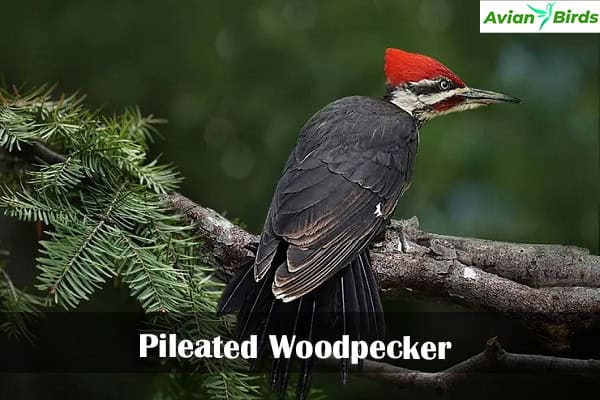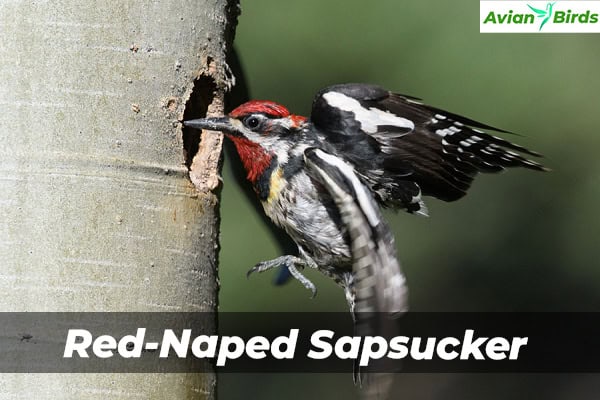6 Types of Woodpeckers Found in Oregon! (ID Guide)
Did you know Oregon has six different types of woodpeckers? These birds are not just pretty. They also help control insects. If you love birdwatching in Oregon, you’ll find many woodpeckers in parks and forests.
This guide will help you learn about Oregon’s woodpeckers. You’ll know how to spot them by their looks and sounds. It’s great for both new and experienced birdwatchers. You’ll learn more about these amazing birds and why they’re important.
Introduction to Woodpeckers in Oregon
Woodpeckers are amazing birds known for their drumming sounds and important roles in nature. In Oregon, they live in many places, from homes to big forests. Watching birds in Oregon lets you see these birds up close.
Learning about woodpeckers helps you tell them apart. You can spot them by their bright colours, shapes, and sounds. For example, the Lewis’s Woodpecker is very interesting to birdwatchers. Oregon has many woodpeckers, like the Downy and Acorn Woodpeckers, each living in different places.
Knowing how to spot woodpeckers makes watching them even better. You’ll learn about their eating habits and where they nest. Watching woodpeckers in Oregon will make you love birds even more.
Overview of Woodpecker Species in Oregon
Oregon is home to twelve native woodpecker species, each with unique traits and habitats. The Downy Woodpecker is small and often seen in cities. It’s the smallest in North America, about 6 to 7 inches long and 1 ounce heavy.
It lives for 2 to 5 years. You can find it in the suburbs and parks.
The Northern Flicker is also common. It’s 8 to 10 inches long and weighs 2.5 ounces. It loves open forests and fields. It lives for 5 to 8 years, making it a regular sight in Oregon.
The Pileated Woodpecker is bigger and found in mature forests. It’s 15 to 19 inches long and has a Least Concern status. Its loud drilling is a sign of its presence in dense woods.
Exploring Oregon’s forests, parks, and cities can be more fun with knowledge of these woodpeckers. Each species shows its own unique traits and behaviours, adding to Oregon’s rich bird diversity.
| Woodpecker Species | Size (inches) | Weight (oz) | Average Lifespan (years) | Conservation Status |
|---|---|---|---|---|
| Downy Woodpecker | 6-7 | 1 | 2-5 | Least Concern |
| Northern Flicker | 8-10 | 2.5 | 5-8 | Least Concern |
| Pileated Woodpecker | 15-19 | 8-12 | Up to 10 | Least Concern |
| Hairy Woodpecker | 7-10 | 1.5 | 5-10 | Least Concern |
| Lewis’s Woodpecker | 9-10 | 2.5 | 5-6 | Least Concern |
| Red-Naped Sapsucker | 7-8 | 1-1.6 | 7-8 | Least Concern |
Physical Characteristics and Identification
Identifying woodpeckers depends on knowing their physical traits. These traits vary among species. It’s key to notice size, colour, and patterns to spot these birds.
The Downy Woodpecker is the smallest in Oregon. The Pileated Woodpecker is the largest, almost 20 inches long. The Hairy Woodpecker is bigger than the Downy and lives in woods and suburbs.
Color helps too. Northern Flickers have brown with black spots. They’re easy to spot in open areas and parks. The acorn woodpecker is black and white with a red cap and throat, found in oak forests.
Head markings are also important. The red-breasted sapsucker has a red throat and breast, while the white-headed woodpecker has a white head and neck.
Woodpeckers have long, pointed beaks for pecking trees. The northern flicker’s beak is strong for ground foraging. The acorn woodpecker’s beak drills into the bark.
Knowing these traits helps you spot woodpeckers in Oregon. It’s fun to learn about the Northern Flicker and the rare American Three-Toed Woodpecker.
1. Downy Woodpecker
- Scientific Name: Picoides pubescens
- Size: 14–19 cm (5.5–7.5 in)
- Weight: 28–90 g (1–3.2 oz)
- Lifespan: Up to 10 years in the wild
- Diet: Insects, larvae, seeds, and berries
The Downy Woodpecker is a joy to see in backyards. It’s small and looks great. Bird watchers and backyard birders love it because it comes to feeders and trees.

Identification Features
Finding a Downy Woodpecker is easy. It’s between 5.5 and 6.7 inches long. It has a white belly and a black back with white spots.
The male has a red spot on his head, while the females don’t. In the Pacific Northwest, they look darker than those in the East.
Feeding Habits
Downy Woodpeckers eat insects and tree sap. They search tree trunks and branches, using their sharp beaks to find insects in the bark.
They like suet, sunflower seeds, and peanuts. During breeding, both parents care for their young for up to three weeks.
2. Hairy Woodpecker
- Scientific Name: Picoides villosus
- Size: 20–23 cm (7.9–9.1 in)
- Weight: 70–100 g (2.5–3.5 oz)
- Lifespan: Up to 15 years in the wild
- Diet: Insects, especially wood-boring beetles, along with some seeds and fruits
The Hairy Woodpecker is bigger and has unique features. It’s 7.1 to 10.2 inches long. It looks like the Downy Woodpecker but has clear differences. Knowing these traits can make birdwatching more fun.

Identifying Characteristics
The Hairy Woodpecker has a longer bill than the Downy. Its tail feathers are all white. Males have a bright red head patch. Watching them helps you learn to identify birds.
Behavior and Diet
Hairy Woodpeckers live in big forests and backyards with tall trees. They eat insects under tree bark. Their drumming sounds differ from the Downy’s, making them easy to spot. They are interesting to watch for bird lovers.
| Characteristic | Hairy Woodpecker | Downy Woodpecker |
|---|---|---|
| Size | 7.1 to 10.2 inches | Less than 7 inches |
| Bill Length | Longer | Shorter |
| Outer Tail Feathers | Completely white | Not completely white |
| Male Head Patch | Red | No red patch |
| Typical Habitat | Mature forests and suburban areas | Widespread in various habitats |
3. Northern Flicker
- Scientific Name: Colaptes auratus
- Size: 30–36 cm (12–14 in)
- Weight: 90–150 g (3.2–5.3 oz)
- Lifespan: Up to 9 years in the wild
- Diet: Primarily ants and beetles, along with seeds and fruits
The Northern Flicker is special among woodpeckers because it forages on the ground. It looks for ants and beetles by digging in the soil. This unique way of finding food makes it easy to spot and adds to its interesting story.

Unique Traits
Male and female Northern Flickers look alike, with a bright red moustache stripe. Their underwings and tails shine in flight. These colours make them stand out and help them interact with their world.
Preferred Habitat
Northern Flickers live in many places, including open woods and cities. Like other woodpeckers, they like to nest in tree holes, but they also use old burrows from Belted Kingfishers and Bank Swallows. This shows how well they adapt to different homes.
4. Pileated Woodpecker
- Scientific Name: Dryocopus pileatus
- Size: 38–49 cm (15–19 in)
- Weight: 250–400 g (8.8–14.1 oz)
- Lifespan: Up to 12 years in the wild
- Diet: Primarily wood-boring insects
The Pileated Woodpecker is a standout in Oregon’s forests. It’s as big as a crow and has unique features. Its black body and white stripes on its face and neck are striking. Plus, its bright red crest adds to its beauty.

Size and Appearance
This bird can grow up to 19 inches long. It’s the biggest woodpecker in Oregon. Males have a red crest and cheek stripe, while females have a crest but no cheek stripe.
They can be seen on fallen logs. Their strong bills make holes for carpenter ants and other insects.
Vocalizations and Sounds
The Pileated Woodpecker is not quiet. It makes a “cuk-cuk-cuk” sound that fills the woods. You can also hear their drumming, a slow and powerful beat.
Juvenile and female nestlings make loud calls from the nest. Their sounds are unforgettable in the wild.
5. Lewis’s Woodpecker
- Scientific Name: Melanerpes lewis
- Size: 23–28 cm (9–11 in)
- Weight: 70–100 g (2.5–3.5 oz)
- Lifespan: Up to 10 years in the wild
- Diet: Primarily insects, but also seeds and fruits
The Lewis’s Woodpecker is a unique bird. Its pink belly, grey collar, and greenback make it stand out. Unlike most woodpeckers, it’s also known for hunting in the air.

Distinctive Features
Both male and female Lewis’s Woodpeckers look similar, but males are a bit bigger. During breeding season, which lasts from late April to July, they live in open forests and burned areas. Their neck collar is a special feature that early naturalists like Alexander Wilson admired.
Feeding Techniques
This bird catches insects in mid-air, like flycatchers do. It doesn’t drill into trees like other woodpeckers. Instead, it waits on a perch for insects to come by. Insects are their main food in warm months, but they also eat fruits.
In some places, they even store acorns and nuts in tree holes, which shows how adaptable they are. Birdwatchers love to observe their unique hunting methods.
| Characteristic | Details |
|---|---|
| Size | Flicker-sized |
| Colouration | Pink belly, grey collar, iridescent-green back |
| Breeding Season | Mid-April to early June |
| Typical Diet | Insects and fruits |
| Nesting Behavior | Nests in cavities; lays 5 to 9 eggs |
| Migratory Patterns | Some migrate south; others remain year-round |
| Habitat Preference | Open timberland, post-fire landscapes |
6. Red-naped Sapsucker
- Scientific Name: Sphyrapicus nuchalis
- Size: 20–23 cm (7.9–9.1 in)
- Weight: 50–80 g (1.8–2.8 oz)
- Lifespan: Up to 6 years in the wild
- Diet: Primarily tree sap, along with insects and fruits
The Red-naped Sapsucker is a woodpecker that taps into trees. It lives in places like Oregon and makes holes in tree bark. These holes let the bird get to the sap inside the tree.

This bird has a bright red head and breast, a white spot near its eye and bill, a clear white patch on its wings, and a mottled black-and-white back, which help it stand out in nature.
The Red-naped Sapsucker taps into trees with skill. It uses its beak to make holes in the tree. This lets it get sap and insects to eat.
This behavior helps the ecosystem too. The holes attract other animals. Red-naped Sapsuckers breed in the Rocky Mountains and move south for winter. They lay 4 to 7 eggs at a time. The young birds leave the nest after about 3 to 4 weeks.
Woodpeckers of Oregon: Habitats and Ranges
Oregon has many places where woodpeckers live. They can be found in the forests of the Cascade Mountains and the woodlands of the Columbia River Gorge. Lewis’s Woodpecker likes open areas with oak and ponderosa pine trees, but these places are becoming fewer.
The Columbia Land Trust is working hard to save these homes. They bought over 1,000 acres to help Lewis’s Woodpeckers. Mill Creek Ridge is a key spot for them, with great oak and pine trees.
Other woodpeckers, like the Pileated Woodpecker, also live in Oregon. They are common in the East but rare in the West. Pileated Woodpeckers like to find food on logs and snags. They can live in different places in Oregon.
Oregon is home to over 200 bird species, including eleven woodpeckers. Places like the Malheur National Wildlife Refuge and the Silvies River floodplain are very important. They help many birds, both those that migrate and those that stay all year.
Where to spot Woodpeckers in Oregon
Here are some of the best places in Oregon to spot woodpeckers:
1. Mount Hood National Forest
- One of the top locations to see woodpeckers, especially the Pileated Woodpecker, which thrives in this forest’s mature and old-growth trees.
2. Deschutes National Forest
- Known for Hairy Woodpeckers, Northern Flickers, and other species. The variety of habitats makes it an excellent spot for woodpecker watching.
3. Willamette National Forest
- The diverse range of elevations and tree types make this a prime location for woodpeckers, including Red-breasted Sapsuckers.
4. Malheur National Wildlife Refuge
- In southeast Oregon, this refuge is a hotspot for birdwatchers. You can often spot Lewis’s Woodpecker and Northern Flicker here, especially in the spring and fall migration seasons.
5. Ochoco National Forest
- A great place for observing Acorn Woodpeckers, Pileated Woodpeckers, and other species in the ponderosa pine forests.
6. Silver Falls State Park
- Located near Salem, this park is popular for hiking and birdwatching, with woodpeckers like Hairy Woodpeckers and Downy Woodpeckers frequently spotted.
7. Siuslaw National Forest
- Coastal forests often feature species like the Acorn Woodpecker and Northern Flicker. It’s also an excellent spot for viewing wildlife in general.
8. Portland’s Forest Park
- One of the largest urban forests in the U.S., it offers great chances to spot woodpeckers like Downy Woodpeckers, Hairy Woodpeckers, and Northern Flickers.
9. Ankeny National Wildlife Refuge
- Located in the Willamette Valley, this refuge is home to species like the Downy Woodpecker and Northern Flicker. It’s a peaceful spot for birdwatching year-round.
10. Bend Area (Sisters and Sunriver)
- These areas, especially in Newberry National Volcanic Monument, offer opportunities to see White-headed Woodpeckers and other species like Hairy Woodpeckers and Northern Flickers.
11. Hells Canyon National Recreation Area
- In northeastern Oregon, this rugged and remote area hosts a variety of woodpecker species, including Lewis’s Woodpecker and Pileated Woodpecker.
Read More🐦Related Articles:
| Woodpeckers in Indiana |
| Woodpeckers in Arizona |
| Woodpeckers in Maryland |
| Yellowhammer: Alabama’s Vibrant State Bird |
| Budgerigar: The Perfect Pet Parakeet |
Conclusion
Woodpeckers in Oregon are key to the ecosystem. They come in many types, like the Pileated Woodpecker and the Northern Flicker. Each has special ways to live in different places.
Knowing how they live shows why we need to keep nature around. This helps them survive and thrive.
This guide helps you see how amazing woodpeckers are and how important their homes are to them. For example, Pileated Woodpeckers love old forests.
Watching these birds can make you love nature more. Every time you see one, it’s a special moment.
Helping their homes means helping them survive. So, get your binoculars ready. Let’s see the woodpeckers in Oregon!







